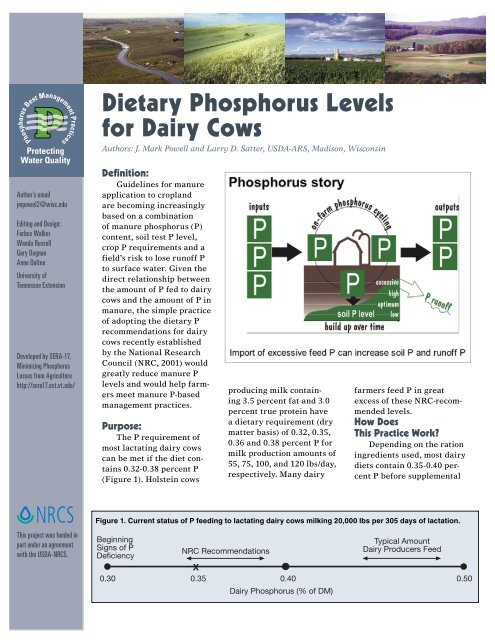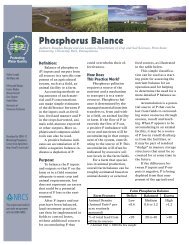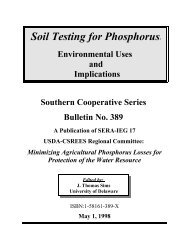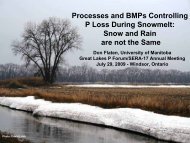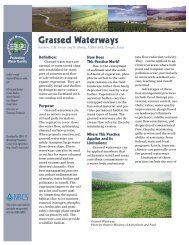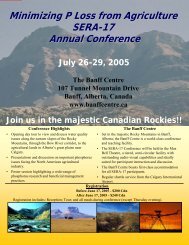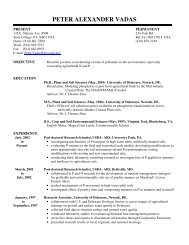Dietary Phosphorus Levels for Dairy Cows - Sera-17
Dietary Phosphorus Levels for Dairy Cows - Sera-17
Dietary Phosphorus Levels for Dairy Cows - Sera-17
Create successful ePaper yourself
Turn your PDF publications into a flip-book with our unique Google optimized e-Paper software.
P<br />
Protecting<br />
Water Quality<br />
<strong>Phosphorus</strong> Best Management Practices<br />
Author’s email<br />
jmpowel2@wisc.edu<br />
Editing and Design:<br />
Forbes Walker<br />
Wanda Russell<br />
Gary Dagnan<br />
Anne Dalton<br />
University of<br />
Tennessee Extension<br />
Developed by SERA-<strong>17</strong>,<br />
Minimizing <strong>Phosphorus</strong><br />
Losses from Agriculture<br />
http://sera<strong>17</strong>.ext.vt.edu/<br />
NRCS<br />
This project was funded in<br />
part under an agreement<br />
with the USDA-NRCS.<br />
<strong>Dietary</strong> <strong>Phosphorus</strong> <strong>Levels</strong><br />
<strong>for</strong> <strong>Dairy</strong> <strong>Cows</strong><br />
Authors: J. Mark Powell and Larry D. Satter, USDA-ARS, Madison, Wisconsin<br />
Definition:<br />
Guidelines <strong>for</strong> manure<br />
application to cropland<br />
are becoming increasingly<br />
based on a combination<br />
of manure phosphorus (P)<br />
content, soil test P level,<br />
crop P requirements and a<br />
field’s risk to lose runoff P<br />
to surface water. Given the<br />
direct relationship between<br />
the amount of P fed to dairy<br />
cows and the amount of P in<br />
manure, the simple practice<br />
of adopting the dietary P<br />
recommendations <strong>for</strong> dairy<br />
cows recently established<br />
by the National Research<br />
Council (NRC, 2001) would<br />
greatly reduce manure P<br />
levels and would help farmers<br />
meet manure P-based<br />
management practices.<br />
Purpose:<br />
The P requirement of<br />
most lactating dairy cows<br />
can be met if the diet contains<br />
0.32-0.38 percent P<br />
(Figure 1). Holstein cows<br />
producing milk containing<br />
3.5 percent fat and 3.0<br />
percent true protein have<br />
a dietary requirement (dry<br />
matter basis) of 0.32, 0.35,<br />
0.36 and 0.38 percent P <strong>for</strong><br />
milk production amounts of<br />
55, 75, 100, and 120 lbs/day,<br />
respectively. Many dairy<br />
farmers feed P in great<br />
excess of these NRC-recommended<br />
levels.<br />
How Does<br />
This Practice Work?<br />
Depending on the ration<br />
ingredients used, most dairy<br />
diets contain 0.35-0.40 percent<br />
P be<strong>for</strong>e supplemental<br />
Figure 1. Current status of P feeding to lactating dairy cows milking 20,000 lbs per 305 days of lactation.<br />
Beginning<br />
Typical Amount<br />
Signs of P<br />
NRC Recommendations<br />
<strong>Dairy</strong> Producers Feed<br />
Deficiency<br />
X<br />
0.30 0.35 0.40 0.50<br />
<strong>Dairy</strong> <strong>Phosphorus</strong> (% of DM)
Table 1. Protein and phosphorus concentrations<br />
in common dairy protein supplements.<br />
Feed<br />
Protein<br />
content<br />
% DM<br />
<strong>Phosphorus</strong><br />
content<br />
%<br />
Protein:<br />
<strong>Phosphorus</strong><br />
ratio<br />
Blood meal 95 0.30 3<strong>17</strong><br />
Corn gluten meal (dried 65 0.60 108<br />
Soybean meal (expellers) 46 0.66 65<br />
Soybean (roasted) 43 0.64 67<br />
Brewer’s grain (dried) 29 0.67 44<br />
Cottonsee 23 0.60 38<br />
Corn distiller’s grain 29 0.83 35<br />
Wheat midds 18 1.02 18<br />
Wheat bran <strong>17</strong> 1.18 14<br />
Meat and bone meal 54 4.73 11<br />
mineral P is added. Because such<br />
diets already contain sufficient P<br />
<strong>for</strong> high milk production, the simple<br />
elimination of mineral P supplements<br />
may be sufficient to<br />
eliminate excessive P feeding. All<br />
P in excess of dietary requirement<br />
is excreted in manure.<br />
In addition to mineral P, a<br />
large part of excessive dietary P<br />
may come from protein supplements.<br />
The selection of protein<br />
supplements is usually based on<br />
their availability and how they fit<br />
into a least-cost ration. The protein<br />
supplements commonly used<br />
in dairy rations contain a very<br />
wide range of P concentrations<br />
(Table 1). For dairy farms attempting<br />
to improve P management, the<br />
choice of a low-P protein supplement<br />
could have a major impact<br />
on manure P, land requirement <strong>for</strong><br />
manure application (Table 2) and<br />
the farm’s accumulation and loss<br />
of P.<br />
Grouping cows by milk production<br />
level would enable a closer<br />
match between dietary P and P<br />
requirement. For example, it is<br />
fairly common <strong>for</strong> dairy producers<br />
to split the herd into two or three<br />
groups according to milk production<br />
or stage of lactation, and <strong>for</strong>mulate<br />
diets to meet the nutritional<br />
needs of each group. A reasonable<br />
approach to feeding P levels<br />
close to herd requirements may be<br />
to <strong>for</strong>mulate group rations using<br />
NRC recommendations that match<br />
the average milk production level<br />
of the top 25 percent of cows in a<br />
Table 2. Amount of P fed and excreted by a lactating cow producing<br />
20,000 lbs milk in 305 days, and the amount of land required<br />
to effectively use manure P.<br />
<strong>Dietary</strong> P<br />
concentration<br />
Estimated<br />
Supplemental P Manure P<br />
Land area<br />
needed<br />
to recycle<br />
manure P<br />
Change in<br />
land area<br />
(%) (lbs/lactation) (lbs/lactation) (acres) (%)<br />
0.35 0 34.8 1.3 Base<br />
0.40 7.5 42.3 1.6 23<br />
0.48 19.6 54.5 2.0 53<br />
0.55 30.2 60.0 2.4 83<br />
feeding group. If this were done,<br />
then high-production groups in<br />
the highest-producing herds would<br />
meet their P requirement with a<br />
reasonable margin of safety by<br />
feeding diets containing 0.36 - 0.40<br />
percent P. This amount of dietary<br />
P can be supplied with little or no<br />
use of mineral P supplements and<br />
represents a significant reduction<br />
in P content of the average dairy<br />
diet fed. Reducing P content of<br />
dairy diets from 0.45 to 0.38 percent<br />
represents a 15-20 percent reduction<br />
in dietary P, and a 20 – 25<br />
percent reduction in manure P.<br />
Reducing dietary P concentrations<br />
below 0.36 – 0.40 percent could be<br />
done <strong>for</strong> low-producing cows, but<br />
low-diet P ingredients would have<br />
to be used, and that could be more<br />
costly.<br />
Where This Practice Applies<br />
and Its Limitations:<br />
The reduction or elimination<br />
of mineral P supplements so dietary<br />
P levels meet NRC recommendations<br />
can be practiced on<br />
any dairy farm. A possible limitation<br />
may be the <strong>for</strong>mulation of<br />
least-cost rations using protein<br />
supplements high in P. Table 1<br />
provides a guide <strong>for</strong> selecting protein<br />
supplements that have low P<br />
content<br />
Effectiveness:<br />
Feeding P in excess of NRCrecommended<br />
levels does not<br />
increase milk production, milk<br />
composition or reproductive per<strong>for</strong>mance<br />
of the cows. It simply<br />
increases manure P excretion<br />
and, there<strong>for</strong>e, the amount of land<br />
needed to effectively recycle manure<br />
P through crops (Table 2).<br />
Assumptions: Cow is consuming<br />
an average of 49.6 lbs DM<br />
daily, and milk contains 0.09 percent<br />
P. There is no net change in P<br />
content of the cow. The cropping<br />
area is comprised of 37 percent
corn <strong>for</strong> grain, 7 percent corn <strong>for</strong><br />
silage, 47 percent alfalfa and 9<br />
percent soybeans. Crop yields are<br />
typical <strong>for</strong> the Midwest US, and<br />
crops remove 27 lbs P per acre per<br />
year. Manure application rate is<br />
based on crop P removal.<br />
In addition to reducing the<br />
manure P levels and the amount<br />
of cropland needed to recycle<br />
manure, feeding P to NRC-recommended<br />
levels also aligns the N:P<br />
ratio of manure to coincide closely<br />
with N:P ratio of crops. This<br />
means that when manure from<br />
cows fed excessive amounts of P is<br />
applied to cropland in amounts to<br />
meet a crop N demand, soil test P<br />
would increase much more quickly.<br />
Increased soil test P increases<br />
the risk of runoff P.<br />
Reductions of diet P to recommended<br />
levels not only decreases<br />
manure P excretions but also<br />
greatly reduces the potential <strong>for</strong><br />
runoff of soluble P from manureamended<br />
fields. A recent field<br />
trial showed that when manure<br />
from dairy cows fed a high (0.49<br />
percent) and low (0.31 percent)<br />
P diet were applied at equal<br />
amounts, difference in P runoff<br />
between plots amended with high<br />
P manure was eight to 10 times<br />
greater than from plots amended<br />
with the low P manure. When<br />
manure was applied at equivalent<br />
rates of P (36 lbs. P per acre),<br />
runoff concentrations and loads<br />
from plots amended with the high<br />
P manure were approximately<br />
four to five times those from the<br />
low P manure. Excessive diet P<br />
supplementation increases both<br />
total and water-soluble P content<br />
of manure.<br />
Cost of Establishing and<br />
Putting the Practice in Place:<br />
Separate feed, fertilizer and<br />
manure management strategies<br />
that do not consider balancing<br />
on-farm P inputs and outputs can<br />
result in loss of profits through<br />
excessive P use, undesirable P accumulation<br />
in soil, and increased<br />
risk of negative environmental<br />
impacts. Diet P reductions to<br />
NRC-recommended levels would<br />
eliminate the purchase of unnecessary<br />
mineral P supplements and<br />
decrease manure spreading costs,<br />
as less cropland would be required<br />
<strong>for</strong> manure P recycling (Table 2).<br />
Many dairy producers already<br />
have reduced diet P levels and<br />
have saved money. For example,<br />
surveys and other studies have<br />
shown that the average P content<br />
of dairy diets recommended by
consultants and the feed industry<br />
in 1999 was approximately 0.48<br />
percent of ration dry matter. The<br />
average P content of dairy rations<br />
in 2003 is estimated to be about<br />
0.44 percent. If the target dietary<br />
P level is NRC’s recommendation<br />
of 0.38 percent <strong>for</strong> high-producing<br />
dairy cows, then we have<br />
come about one-third of the way<br />
toward these recommendations.<br />
The reduction of diet P levels has<br />
already saved U.S. dairy farmers<br />
$30-35 million annually, and<br />
has the potential of an additional<br />
savings of $65-70 million. The<br />
reduced environmental risk associated<br />
with P runoff loss from<br />
manure-amended fields, and the<br />
potential to reduce eutrophication<br />
of fresh-water systems, would be<br />
potentially enormous.<br />
Operation and Maintenance:<br />
Any strategy aimed at improving<br />
P use on dairy farms,<br />
including dietary practices, must<br />
be done in partnership with the<br />
consultants, feed industry, veterinarians<br />
and others who assist<br />
dairy farmers in making nutrient<br />
management decisions.<br />
References:<br />
Ebeling, A.M., L.G. Bundy, J.M.<br />
Powell, and T.W. Andraski,<br />
2002. <strong>Dairy</strong> diet phosphorus effects<br />
on phosphorus losses in runoff<br />
from land-applied manure Soil<br />
Sci. Soc. Am. J. 66:284-291.<br />
NRC. 2001. National Research<br />
Council. Nutrient Requirements<br />
of <strong>Dairy</strong> Cattle. Seventh Revised<br />
Edition. National Academy<br />
Press, Washington, D.C.<br />
Powell J.M., Z Wu and L.D. Satter,<br />
2001. <strong>Dairy</strong> diet effects on phosphorus<br />
cycles of cropland. J. Soil<br />
and Water Conserv. 56 (1): 22-26.<br />
For Further In<strong>for</strong>mation:<br />
Contact dairy Extension specialists<br />
and Extension agents, feed<br />
consultants and veterinarians.<br />
Partial funding <strong>for</strong> this work was received<br />
from USDA-CSREES Initiative<br />
<strong>for</strong> Future Agricultural and Food<br />
Systems, Grant 00-52103-9658 and NRI<br />
Agricultural Systems Program, Grant<br />
01-35108-10698<br />
The U.S. Department of Agriculture (USDA) prohibits discrimination in all its programs and activities on the basis of race, color, national origin, sex, religion, age, disability, political beliefs, sexual orientation,<br />
and marital or family status. (Not all prohibited bases apply to all programs.) Persons with disabilities who require alternative means <strong>for</strong> communication of program in<strong>for</strong>mation (Braille, large print, audiotape,<br />
etc.) should contact USDA’s TARGET Center at 202-720-2600 (voice and TDD).<br />
To file a complaint of discrimination write USDA, Director, Office of Civil Rights, Room 326-W, Whitten Building, 14th and Independence Avenue, SW, Washington, DC 20250-9410 or call 202-720-5964 (voice or<br />
TDD). USDA is an equal opportunity provider and employer.


